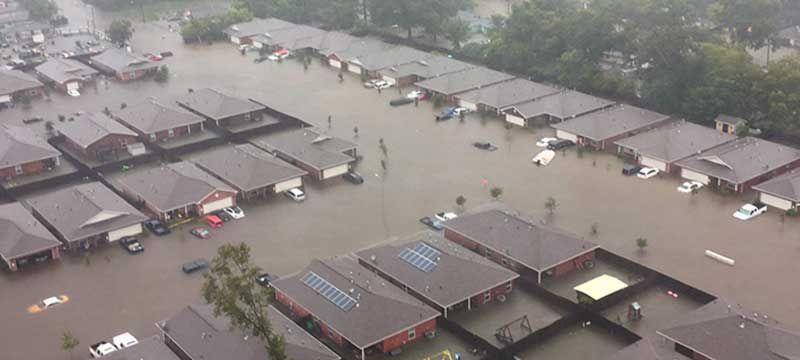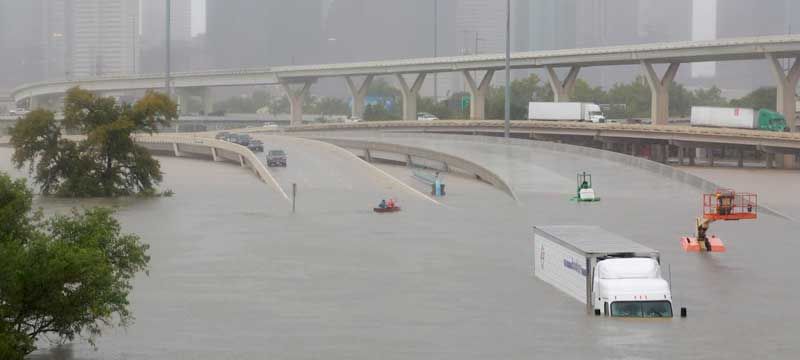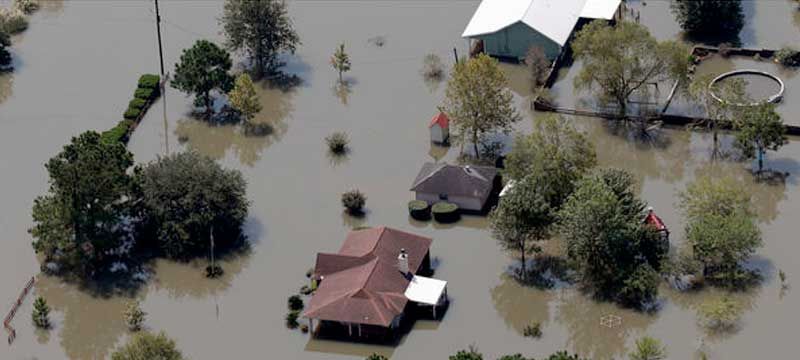Redesigning for Hydraulic Society: What Would a New Houston Look Like?
Published on by Peter Neill, Director, World Ocean Observatory in Academic
Beyond the tragic stories and estimates of loss, what are the questions that must be asked, the lessons to be learned from this catastrophe?
The understanding of how water moves can inform its collection, diversion, utility, and protection, turning water into a net-positive catalyst for the invention of a new city: redirected and revivified by water, aligned with the forces of Nature, integrated by a new idea of commonality and community, and prepared to meet the challenges of a new century and a sustainable future.

The images are devastating — vast areas flooded, pollution and fire, destroyed infrastructure, harrowing tales of rescue, challenges to rebuild almost beyond imagination. Today we see such images as well in India, in Bangladesh, in Niger, and now in Florida; tomorrow those same images will be seen elsewhere.
The message is that extreme weather — rain, flood, and sea level rise — are our enemy. Natural forces unleashed at epic scale are the cause of this devastation and we are their victims. But is that truly the case? Beyond the tragic stories and estimates of loss, what are the questions that must be asked, the lessons to be learned from this catastrophe?
Houston is a city based on a 19th century paradigm of unlimited growth in the name of consumption enabled by fossil fuels; its identity has been formed by oil, chemicals, port operations, and other manifestations of the industrial revolution. Houston has grown exponentially with limited planning, regulation, and foresight, reveling in its freedom, a wildcat mentality that has made its citizens wealthy and made lives better. But that paradigm is now bankrupt, in that the consequences of its application outweigh the benefits. Houston was not concerned with these consequences of culture — the emissions from its refineries, the leaks from its networked pipelines, the toxic waste from its manufacturing, the inadequacies of its water management and treatment systems — and the potential disaster should anything confront these conditions, such as a hurricane with record rainfall, storm surge, or any other natural climate phenomenon in a rapidly changing world.

Rebuilding and Reorganizing for a 21st Century Paradigm
The question today is not so much explanation or blame, rather on what premises to rebuild. The evidence of the storm and flooding provides an outline for a different, perhaps preventative response, not to reconstruct the city as it was, but to redesign it in the face of what surely will be comparable events to come.
What if Houston was to reorganize based on a new 21st century paradigm? What if managed growth was the reorganizing principle, in the name of sustainability enabled by water, the most valuable natural resource on earth? What if Houston rebuilds with this operative paradigm, with water, not as its enemy, but as its friend?
What if Houston revives as a new hydraulic society, a community that understands that its survival depends on the fresh water/ocean continuum that will drive its economy, sustain its community, and establish its viability into the future? To do so will of course require enormous financial resources, but more importantly enormous political will.

Contributions for a Sustainable Future
The paradox of Houston and Texas politicians asking for billions in federal funds for re-construction when they voted against such relief for other cities and states is stunning. Not lost on the governors of New Jersey and New York, this understanding should not be lost either by all taxpayers nationwide who are being asked ultimately to foot the bill.
We should make such a contribution, but not to rebuild Houston as its former self. The lessons of storms such as Katrina and Sandy must not be ignored and we should no longer support reconstruction that will not address the fundamental realities of this changing world.
What would a new Houston look like? The destruction itself suggests a plan. The location of buildings and residences; industrial, refining, and water treatment facilities; highways and bridges; reservoirs and parks can be reviewed in the context of this evidence. New building codes, directed zoning, different construction materials, civil engineering and modern technology, design criteria and reviews can be revised and applied to facilitate such transformation immediately. Directed reconstruction funds, municipal bonds, subsidies, tax incentives, and other more creative financial instruments can be brought to bear on the realization of a city re-envisioned and reborn. The understanding of how water moves can inform its collection, diversion, utility, and protection, turning water into a net-positive catalyst for the invention of a new city, redirected and revivified by water, aligned with the forces of Nature, integrated by a new idea of commonality and community, and prepared to meet the challenges of a new century and a sustainable future.

Hydraulic society is not a new idea. Great civilizations in the past have organized themselves around this essential principle. It was only when they denied changing conditions, or compromised their security through unlimited growth, aspiration, hubris, and war, that they collapsed, often suddenly and completely. Houston’s rebirth could be a turning point in our own civilization now threatened by change, a model for cities everywhere for how we value, structure, and behave successfully in a new world.
Water is essential. We live in a water world. On a water planet. Water is not our enemy: it is the essential element for our security, health, equity, and social justice. Water is life. We should not fear it, but embrace it.
---
PETER NEILL is founder and director of the World Ocean Observatory and is author of “The Once and Future Ocean: Notes Toward a New Hydraulic Society.”
Media
Taxonomy
- Public Health
- Technology
- Environment
- Infrastructure
- Governance & Planning
- Building Construction
- Policy & Safety
- Industrial Construction
- Sustainability
- Water & Energy Conservation
- Public Water System and Groundwater Issues
1 Comment
-
Congratulations for writing the above article, suggesting the formation of Hydraulic Society. The Society itself will not be enough unless we can persuade the people in authority in various countries that long term planning for prevention of floods, is required for least interference with the nature. Such a society would have to be a multi-disciplinary as the water hydrology cycle has to pass through various uses of land and water such as forest, mining, agriculture, industries and urbanisation. The problems of industry and urbanisation would have to be dealt with separately as they would be different from the other land uses. In India such a group does not exists at present and the situation from floods by interfering with nature are getting from bad to worse, although, damages are being done in both cases. Even the new construction are not considering in reducing the interference with nature. With new policy, and technology available at lesser cost can certainly help after due planning. A brief on case study if available, could be added for convincing others.
1 Comment reply
-
This thesis is expanded greatly in my 2016 book, THE ONCE AND FUTURE OCEAN -- Notes Toward a New Hydraulic Society, which is available for e-book download via Amazon.com. The book contains many ideas and examples of how this change might be effected. India of course has been, and remains, at the forefront of both good and not so good water management schemes. The controversy surrounding the present massive restructuring of water systems might be better framed and understood in the context of "hydraulic society" as the paradigm for value, structure, behavior, and survival in the 21st century. How I would love to spread this message in India and see such a Society exist to promote the concept. Thanks for your interest. PN
-